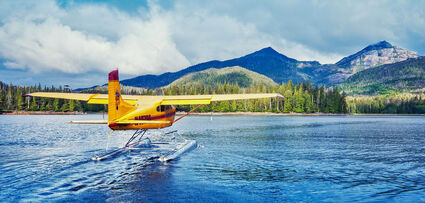More metals, less red tape for Bokan
North of 60 Mining News – October 1, 2019
Last updated 9/26/2020 at 5:46am

Ucore Rare Metals Inc.
A float plane touches down on Kendrick Bay in front of Ucore Rare Metals' Bokan Mountain rare earth elements project on Prince of Wales Island in Southeast Alaska.
Ucore Rare Metals Inc. Sept. 23 reported two developments that could bolster the economics of a mine at Bokan-Dotson Ridge and expedite the permitting of this potential rare earth operation in Southeast Alaska.
The potential boost in economics comes from a recent study that beryllium, zirconium, niobium, and hafnium could be valuable by-products to mining the rare earth elements at Bokan Mountain.
All four of these metals are on the U.S. Geological Survey list of minerals considered critical to the economic and national security of the United States.
Ucore recently received initial results from an initial phase of a scientific co-products metals report carried out by Mr. Edwin H. Bentzen III, a Colorado-based metallurgical engineer.
The preliminary results indicate that beryllium, zirconium, niobium, and hafnium could be viable co-product elements present in the two existing leach streams in the current recovery systems being considered for Bokan. Incidental concentrations of titanium and vanadium, two more critical metals, will also be considered.
"Previous laboratory programs were diligent in tracking co-product metals during the extensive studies conducted during the development of the Bokan flowsheet, as documented in the published 2013 PEA (preliminary economic assessment)," said Bentzen. "We have successfully determined the concentrations of each element of interest at each major juncture of the flowsheet process studies."
Buoyed by these results, Ucore has now engaged Aurora Geosciences (Alaska) Ltd. to analyze the existing data to determine the specific amounts of inferred and/or indicated co-product elements and to correspondingly update the 2015 mineral resource with this new data.
Ucore intends to utilize this forthcoming data to update the incremental costs associated with extracting each of the co-product elements from the updated mineral resource. The results will also be used to apply the net contained value of the co-products as a revenue credit against the 2013 PEA's estimated production cost of US$122.78 per metric ton of mined ore, or roughly US$146 per metric ton when you factor in inflation.
"The CPM (co-products metal) study has delivered a very positive first screening of the value-added co-product metal values present in existing product streams," said Ucore Rare Metals COO Mike Schrider. "As we commence with the engineering steps to incorporate solvent extraction into the overall Bokan process flow sheet, the next co-product steps after the mineral resource update will be to develop the optimized recovery path and to determine the associated incremental costs for these value-added co-product metals in order to fully understand the net economic upside potential for the overall Bokan project."
As Ucore looks into the potential of beryllium, zirconium, niobium, and hafnium boosting the economics of mining the critical rare earth elements at Bokan, management is busy meeting with lawmakers at the state and federal levels. These discussions have focused largely on expediting the permitting at Bokan Mountain.
One positive development on this front, is the White House has instructed Agriculture Secretary Sonny Perdue to accept that the Tongass National Forest is exempt from the 2001 Roadless Area Conservation Rule.
Established by the Clinton administration in 2001, the "roadless rule" prohibits road building and logging on 58.5 million acres of national forest lands, including more than 9 million acres of the Tongass, which includes Prince of Wales Island where Bokan is located.
In 2003, the Bush administration exempted the Southeast Alaska forest from the conservation measure, only to be re-instated by U.S. District Judge John Sedwick in 2011.
The U.S. Department of Agriculture is now developing an Alaska-specific roadless rule that would allow for responsible resource development in certain parts of the Tongass, while still conserving roadless areas for generations to come.
"This potential action, combined with Governor Dunleavy's request for high priority infrastructure project designation for Bokan, should allow Ucore to gain approvals for the project in a substantially shorter time frame, adding to the project's appeal as a potential near-term source of critical rare earths to the American defense, energy, and technology sectors," said Schrider.

Ucore Rare Metals Inc.
Rare earths produced from a solution derived from Bokan Mountain. In addition to REEs, Ucore is studying the potential of recovering the beryllium, zirconium, niobium, and hafnium also present at this Southeast Alaska deposit.
Further details of Alaska Gov. Michael Dunleavy's nomination can be read at "Alaska gov nominates Bokan REE as priority" in the Sept. 13 edition of North of 60 Mining News.
Ucore says the potential of expedited permitting does not exempt the project from the strict environmental standards in the U.S. and Alaska. In fact, the company is proud of design components that eliminate the need for surface storage of tailings, except for a small amount during the early stages of underground development.
"Natural resource development projects such as Bokan will continue to be regulated and designed with due environmental considerations," said Ucore Rare Metals Vice President of Project Development Randy MacGillivray. "The Ucore team takes environmental stewardship very seriously, and we are especially proud of our unique, clean, green operating plan that takes advantage of X-ray ore sorting and recycling to provide for a proposed underground mine project without a tailings dam."
–SHANE LASLEY













Reader Comments(0)